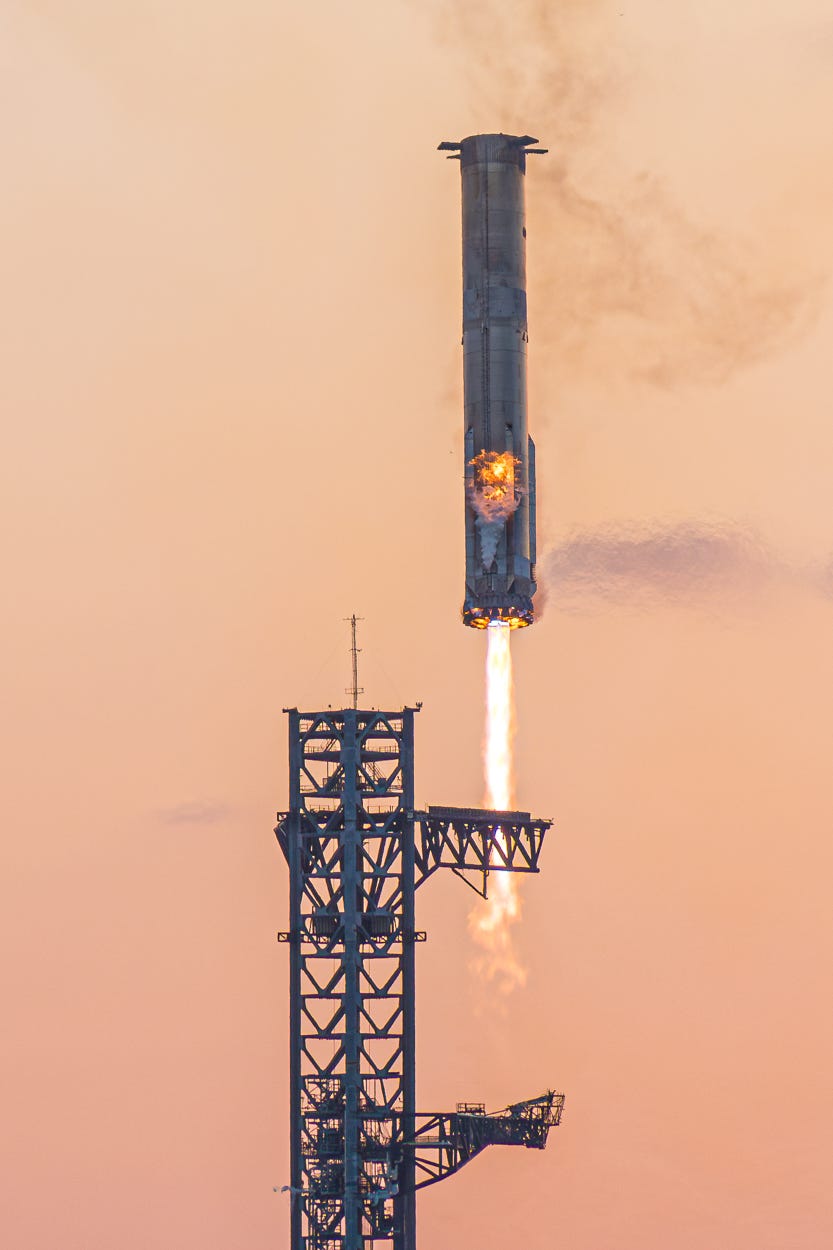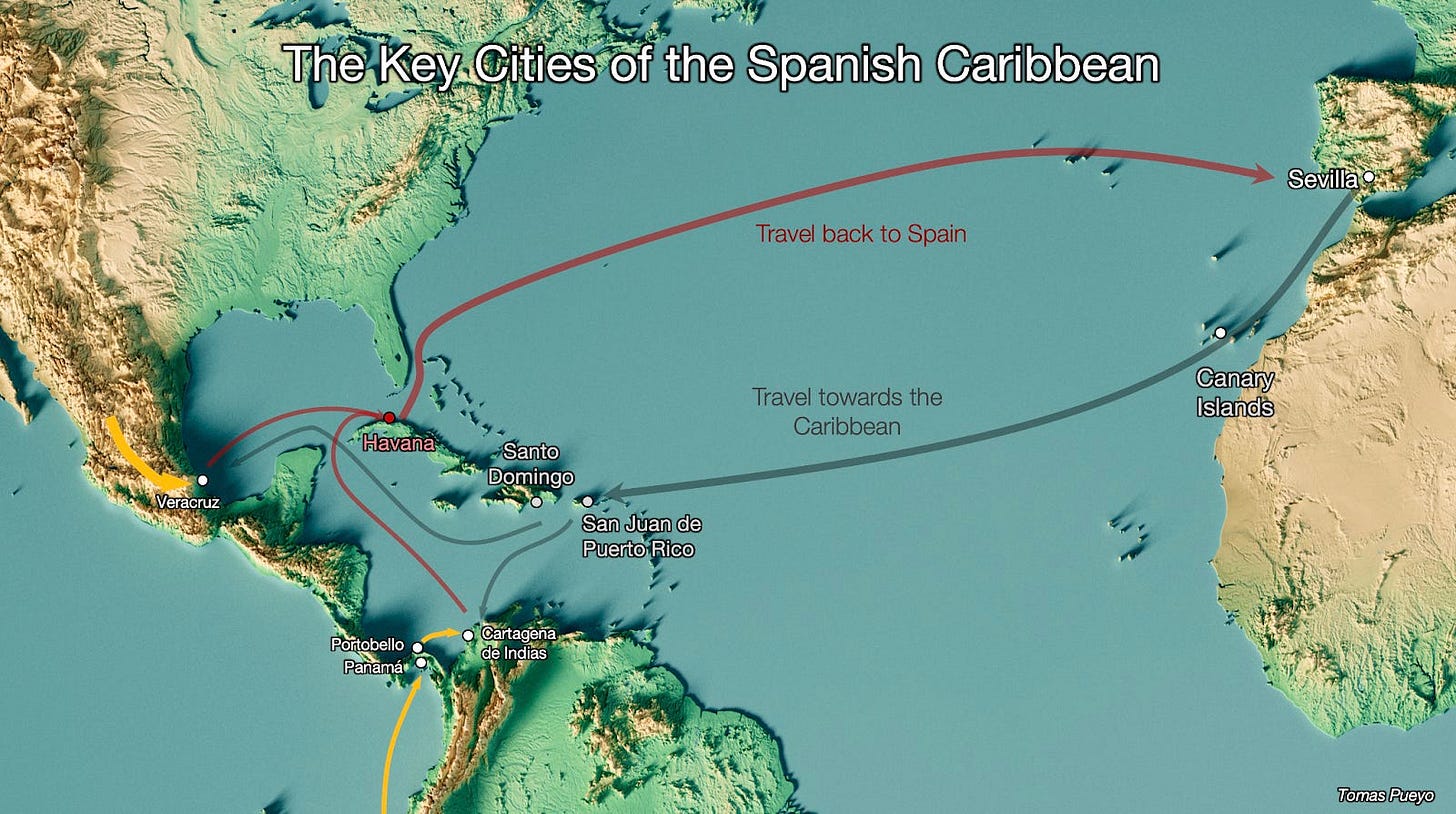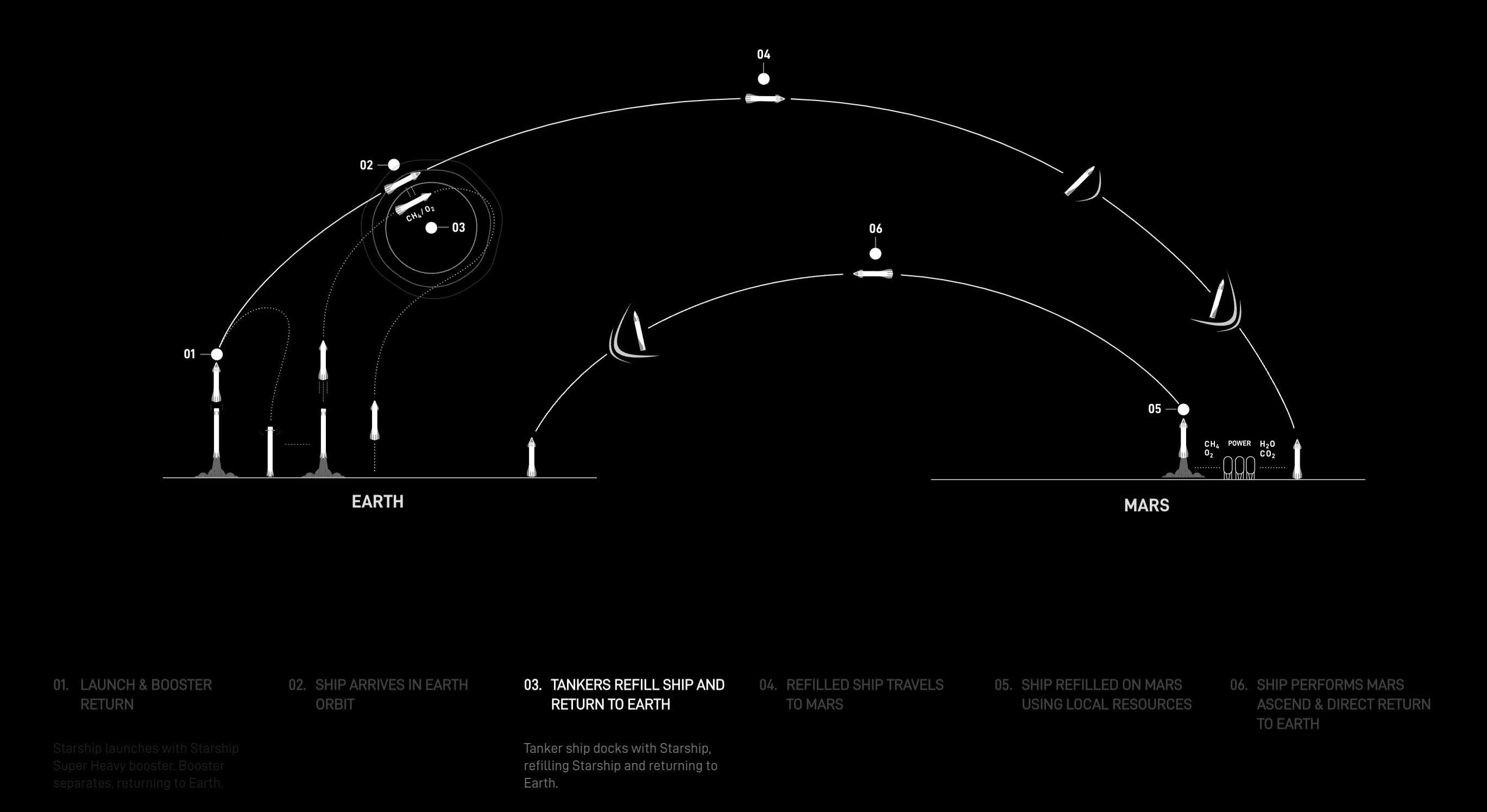🪐 How Will We Ride to Mars?
Part 5 of the Space Series
It finally happened! SpaceX was able to land Starship back on Earth!
Not only that, but it also got caught mid-air by the Mechazilla arms!
We’re now on path to make Mars freaking inhabitable.
The next steps are:
2 years ➡️ First uncrewed Starships launch to Mars during the next Earth-Mars transfer window to test landing reliability.
4 years ➡️ If the uncrewed landings are successful, first crewed flights to Mars.
20 years ➡️ Build a self-sustaining city on Mars, with exponentially more flights arriving.
Long-term ➡️ Humans become a multiplanetary species to increase the lifespan of consciousness by reducing dependence on a single planet.
This is the 5th article in the space series. We’ve already investigated what is the best real estate on Mars, we’ve explored Mars’s surface, we analyzed the economics of Starship and how it will change the Earth, and we faced the issue that there is no money to be made going to deep space, but billionaire money is probably enough to settle Mars regardless.
Now that we’re ready to go to Mars, we must ask ourselves:
How are we actually going to get there?
Settle it?
Terraform it?
What will Martian politics be like, based on space geography?
These are the questions we’re going to answer in the upcoming articles. Today, the first one: How are we actually going to get there?
How to Get to Mars
Many experts think building a base on the Moon would help us get to Mars: Since the Moon is close to the Earth and has less gravity than the Earth, maybe it makes sense to use it for pit stops to get to Mars?
Something similar was certainly true in the colonial era. The Canary Islands, Puerto Rico, and Cuba were crucial for Spain’s colonies. The Canary Islands were the last resupply port before the Atlantic crossing, Puerto Rico was the first resupply port on arrival, and Cuba was the springboard to get back to Europe. The Portuguese Madeira and the Açores had a similar value as a last resupply port for trips coming back from America.
This was due to the Atlantic currents and winds.
Is there an equivalent in space? Is it the moon?
The Moon Station
One of the big problems that illustrate the difficulty of space exploration is this: How would we power a Lunar base?
How Do We Get Energy to the Moon?
In a couple of articles, Casey Handmer explores this idea.
The normal way to get energy on the Moon is with photovoltaic panels. That’s all good, except most points on the moon receive sunlight for 14 days and are in the dark for the next 14 (you know, the phases of the moon). How do you get energy for these two dark weeks?
You can’t use batteries, because they’re too expensive: 14 days worth of energy for a full base is a lot, and batteries are heavy. Too expensive to bring to the Moon.
For the same reason, you can’t send fuel.
One of his ideas is to put an antenna at one of the poles, and put it high enough that it always catches the Sun. Put solar panels there. There are two problems with that. One is that polar regions don’t always have easy contact with the Earth. This can be solved by picking a position that is both very illuminated and also always exposed to Earth.

The second problem is that, according to his calculations, the tower would need to measure 3 kms high to always be sunlit. This sounded impossible to him.
I challenged him: we already make livable buildings that are 1 km tall. The limit to go higher is not materials or physics, but elevators. Skyscrapers need to transport many humans so they need many elevators. Here, we wouldn’t need so many. Probably just one, maybe a couple to limit the length of cables1. And since the Moon has 1/6th the gravity of the Earth, we could use much lighter materials. They wouldn’t break under their own weight as easily. Also, since there’s no atmosphere, there is no wind or weather to bother it.
His answer was interesting: Even if you could build it, the materials would need to be brought from the Earth. That’s many tons for a 3 km tower. Even if you built it out of Aluminium, the cost of shipping from Earth would probably be prohibitive.
Another option he considers is a machine that uses the difference in temperature between sunlit regions and dark ones. Water could be put in a tube between these two regions, and this would make it move, and with that movement, create energy. But it sounds like a massive engineering endeavor.
Another option is to ship a nuclear plant to the Moon. The downsides are that this is expensive, and Earthlings might not feel comfortable shipping radioactive materials in an explosive space rocket.
The last possibility is to simply beam the energy from Earth. Apparently, this is doable and the cheapest option!
I didn’t look at the math. But I found it interesting to contemplate unique problems like this facing space settlement, and it’s comforting to know that there are a bunch of geeky but plausible solutions for this one.
OK, so we have some ideas on how to power the Moon. But do we even need it?
Do We Need a Lunar Base?
The key argument for a Lunar base is as a refueling station, because the Moon’s gravity is 1/6th of the Earth’s, so escaping the Moon’s gravity well is easier and cheaper. It doesn’t consume as much fuel. If you land your rocket on the moon and refuel it, you can only fill a fraction of the rocket with fuel, and load much more payload for Mars.
But Elon Musk said: “We don’t need that, we’re going straight to Mars.” One reason is that you can send everything you need to LEO (Low Earth Orbit) and then pack it all up and send it to Mars.
So which one is it?
Casey has a good position on this: “If we can go to Mars, we can probably go to the Moon. Many of the problems will be the same, and the cost will be lower. But we don’t need it to go to Mars.”2
Why?
Traveling long distances in space requires time but no constant consumption of fuel. The most fuel intensive step is getting from Earth to Low Earth Orbit (LEO). The next is escaping LEO, whether to the Moon or Mars or anywhere else. Landing on the Moon takes just as much effort as launching from the Moon, since it has no atmosphere to slow down in. As a result, the Moon is on the way to nowhere except itself. Indeed, just getting to the Lunar surface to refuel would consume more fuel than going directly to almost anywhere else in the inner solar system.—Casey Handmer, In Space No One Can Reason by Analogy
Space Highways
Let’s quantify this. These were the requirements for an Apollo mission to land on the Moon. Look at the black bars:

If you consider the propellant needed to go to the Moon and back, nearly all of it is spent escaping the Earth. Once you’re in space with the right trajectory, nothing slows you down, so if you go in the right direction, you just need to wait. The cost is mostly escaping gravity. So people have made maps on that.
Fuel to Mars

If you add up the numbers, you find that escaping Earth takes you about 12.5 of a thing called delta-v, which represents this difficulty in transporting some weight some distance. But once you’re in space, going to Mars only takes ~half of that3.
Let’s summarize so far:
It takes a lot of fuel to go from the Earth to Mars.
But most of that fuel is spent leaving the Earth’s gravity.
It would cost fuel to land on the Moon and leave it, so refueling from there is dumb unless it’s way cheaper than from the Earth, but right now we’re not producing fuel on the Moon so it makes no sense to make a Lunar base.
Therefore, what makes the most sense is to refuel in the Earth’s orbit:
Send the Mars rocket to the Earth’s orbit
It will have burned too much fuel escaping Earth
So send another rocket that just carries additional fuel
Once in orbit, transfer this surplus fuel to the original rocket meant for Mars
This is the full trip for the rockets:
OK now we have a rocket in the Earth’s orbit, ready to go to Mars! What path should it follow?
Orbiting the Solar System
As the Sun travels in space, its planets follow it:

The Earth takes one year to orbit the Sun, while for Mars it takes nearly one year and eleven months. Since they orbit in the same direction, they end up in the same neighborhood only every 26 months or so. That’s why we say that the launch windows from the Earth to Mars are every two years or so.4
How do you optimally go from the Earth to Mars then? Waiting for the right moment to send the rocket:
Right now we’re pretty close to Mars. The next window will be in 2026. That’s when SpaceX will send Starship to Mars.
Notice how every time we’ve sent probes to Mars in the past, we did so just before the moment when the planets are closest:

How long this trip takes depends on how fast Starship can accelerate and decelerate, but based on its current technology, it will take about 6 months each way.
This is also why Musk doesn’t want to send a single Starship to Mars, but rather a fleet of five, even in the first trip:
So this is how we’re going to Mars:
Send rockets full of useful payload
Send other rockets full of fuel to refuel in orbit
No moon stop
Wait 26 months for the Earth and Mars to be closest
Send the ships all at once
If all goes well in 2026, in 2028 we will have our first crewed mission to Mars. This is in 4 years!
But what happens once we get there?
How do we ship one million people?
Should we start with humans or robots?
Where would the first settlement be?
What would it look like?
How do we survive there?
Let’s explore all of this in next week’s premium article!
Bonus for Premium Subscribers: Slingshots and Lagrange Points
Keep reading with a 7-day free trial
Subscribe to Uncharted Territories to keep reading this post and get 7 days of free access to the full post archives.












